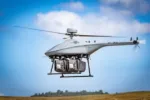At AUSA 2025, Ghost Robotics unveiled the Marauder Modular Unmanned Surface Vessel (USV), a next-generation platform designed to support distributed maritime logistics and autonomous resupply in contested littoral environments. With its modular design and scalable autonomy stack, the Marauder aims to fill critical gaps in expeditionary sustainment for U.S. and allied forces operating in archipelagic or denied-access regions.
Modular Design Tailored for Expeditionary Sustainment
The Marauder USV is built around a modular open architecture that enables rapid reconfiguration for multiple mission profiles—ranging from cargo transport and casualty evacuation to intelligence collection and decoy operations. Measuring approximately 6 meters in length with a payload capacity of over 1,000 kg (2,200 lbs), the vessel features a flat-deck configuration with standardized mounting points for ISO containers or mission-specific modules.
Key features include:
- Payload Flexibility: Compatible with NATO-standard cargo pallets or custom mission kits.
- Shallow Draft: Optimized hull form enables beach landings or operations in rivers and estuaries.
- Autonomy Stack: Integrated with Ghost Robotics’ proprietary AI navigation suite supporting GPS-denied navigation and obstacle avoidance.
This modularity aligns with emerging U.S. Marine Corps concepts such as Expeditionary Advanced Base Operations (EABO) and Littoral Operations in a Contested Environment (LOCE), which emphasize dispersed maneuver across island chains with minimal logistical footprints.
Autonomous Resupply in Contested Littorals
The Marauder’s primary role is autonomous resupply—delivering fuel, ammunition, food, or medical supplies to forward-deployed units without risking manned platforms. Its autonomy suite supports waypoint navigation as well as dynamic rerouting based on sensor input or remote operator override via SATCOM or line-of-sight datalinks.
The vessel can be launched from shipboard davits on LPDs/ESBs or transported overland using standard trailers. Once deployed, it can operate autonomously up to several hundred kilometers depending on payload weight and sea state conditions. The use of hybrid-electric propulsion enhances range while reducing acoustic signature—critical for stealthy insertion missions near hostile coastlines.
Interoperability with Joint Force & Autonomous Ecosystem
Marauder is designed to integrate within a broader unmanned logistics ecosystem that includes UAVs (e.g., Skyways V-BAT), UGVs (e.g., Ghost Vision quadrupeds), and optionally manned platforms. It supports common control interfaces compliant with NATO STANAGs and is compatible with emerging Joint All-Domain Command & Control (JADC2) frameworks.
This interoperability allows operators to task the vessel via unified C2 nodes—whether from an amphibious command post ashore or afloat aboard an LCS or ESB. Additionally, its open software architecture allows integration of third-party autonomy stacks or mission-specific AI agents depending on user requirements.
Testing Milestones and Future Plans
According to Ghost Robotics representatives at AUSA 2025, prototype testing began earlier this year at Camp Lejeune’s Onslow Bay test range under supervision from Marine Corps Warfighting Lab (MCWL). Trials included autonomous beach landing drills under GPS-denied conditions using inertial navigation fused with EO/IR shoreline recognition algorithms.
Planned milestones include:
- Q1 2026: Extended endurance trials with full combat loadout across littoral test ranges in Hawaii (PMRF).
- Q3 2026: Integration testing with USN amphibious ships including LPD-17 class via crane launch/recovery systems.
- FY27: Potential limited fielding under USMC Advanced Naval Technology Exercise (ANTX) programs.
The company is also exploring international partnerships—particularly with Indo-Pacific allies such as Japan and Australia—for co-development of regionally adapted variants optimized for local sea states and operational concepts like Australia’s “Littoral Manoeuvre” initiative.
A Growing Trend Toward Autonomous Maritime Logistics
The unveiling of the Marauder adds momentum to a growing trend toward unmanned logistics platforms across all domains—airborne drones delivering blood packets in Ukraine; robotic mules hauling ammo in Europe; now surface vessels ferrying cargo across contested waters without risking sailors’ lives. As peer adversaries develop long-range fires capable of targeting traditional supply nodes, resilient distributed logistics becomes not just desirable but essential.
Marauder joins other efforts such as DARPA’s NOMARS program and Austal USA’s Expeditionary Autonomous Surface Vehicle (EASV) concept in redefining how naval forces sustain operations beyond the beachhead. While questions remain about robustness in rough seas and C2 resilience under jamming conditions, early tests suggest promising utility for short-range intra-theater sustainment missions—especially when paired with other unmanned systems in swarming configurations or layered delivery chains.









